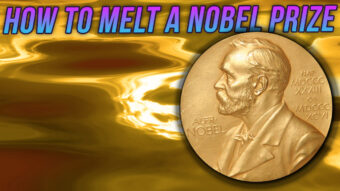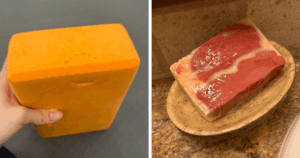Dissolving Gold and the Nazis

 Gold. Since the dawn of civilization, we humans have been obsessed with this most divine of metals. Empires have risen and fallen over it, oceans crossed and continents conquered in search of it, the entire field of chemistry invented to try and make more of it, and – until relatively recently – the entire global economy built around it. And it is not hard to see why. Gold’s distinctive warm yellow glow is unique among metals, evoking for many civilizations the rising sun, royalty, and the divine. Gold is rare enough to be valuable and desirable but not rare enough as to be unobtainable, and is easily extracted from the ground and refined using relatively simple tools and chemicals. It is malleable, ductile, and has a low melting point, allowing it to be easily cast, forged, and drawn into any shape imaginable, and even beaten into gold leaf just a handful of atoms thick. But most importantly, gold is seemingly eternal. It does not tarnish, its lustre does not fade with time, and it is resistant to attack by all chemicals.
Gold. Since the dawn of civilization, we humans have been obsessed with this most divine of metals. Empires have risen and fallen over it, oceans crossed and continents conquered in search of it, the entire field of chemistry invented to try and make more of it, and – until relatively recently – the entire global economy built around it. And it is not hard to see why. Gold’s distinctive warm yellow glow is unique among metals, evoking for many civilizations the rising sun, royalty, and the divine. Gold is rare enough to be valuable and desirable but not rare enough as to be unobtainable, and is easily extracted from the ground and refined using relatively simple tools and chemicals. It is malleable, ductile, and has a low melting point, allowing it to be easily cast, forged, and drawn into any shape imaginable, and even beaten into gold leaf just a handful of atoms thick. But most importantly, gold is seemingly eternal. It does not tarnish, its lustre does not fade with time, and it is resistant to attack by all chemicals.
…well, almost all chemicals. In the 14th Century, an anonymous alchemist writing under the name of 9th Century Islamic polymath Jabir ibn Hayyan – better known to the west as Geber – made an astonishing discovery. Mixing nitric acid with ammonium chloride – then known as sal ammoniac – produced a fuming, highly corrosive solution that could dissolve gold, platinum, and other so-called “noble metals.” The solution, which became known as aqua regia or “royal water,” was seen as a major breakthrough in the quest to discover the Philosopher’s Stone, the mythical substance it was believed could produce the elixir of life and convert base metals like lead into gold. While the Alchemists ultimately failed in their quest, aqua regia – now produced by mixing nitric acid and hydrochloric acid – is still used for etching metal, cleaning traces of metal and organic compounds from laboratory glassware, and in the Wohlwill Process for refining gold to 99.999% purity. But in one strange episode during the Second World War, the corrosive elixir was used for a more dramatic purpose, allowing one brave chemist to save his colleagues’ scientific legacies from the clutches of the Nazis.
In the late 1930s, Nazi Germany was desperate for gold in order to fund their upcoming war of conquest. To this end, they prohibited any gold from leaving the country and, hand-in-hand with their ongoing persecution of the Jews, confiscated vast amounts of gold and other valuables from Jewish families and other persecuted groups. This included the Nobel Prize medals won by German scientists, many of whom had been expelled from their posts in 1933 for having Jewish ancestry. Indeed, in response to jailed journalist and pacifist Carl von Ossietzky receiving the Nobel Peace Prize in 1935, the Nazis forbade all Germans from accepting or keeping any Nobel Prizes. In the late 1920s, Ossietzky had written a number of exposés revealing Germany’s secret rearmament in violation of the 1919 Treaty of Versailles. He was convicted of treason and espionage in 1931 and served a year in prison. Following his release, Ossietzky remained a vocal opponent of German militarism and Nazism, leading to his re-arrest when the Nazis took power in 1933. He was sent to Esterwegen concentration camp, where he died of tuberculosis in 1938.
Among the German scientists affected by the ban were Max von Laue and James Franck. Von Laue had received the Nobel Prize in Physics in 1914 for his work on x-ray diffraction in crystals, while Franck, along with colleague Gustav Hertz, received the 1925 prize for confirming the quantum nature of electrons. In December 1933, von Laue, who was Jewish, was expelled from his advisory position at the Federal Physical and Technical Institute in Braunschweig under the newly-enacted Law for the Restoration of the Professional Civil Service. Franck, though exempt from this law due to his prior military service, nonetheless resigned in protest from the University of Göttingen in April 1933. Along with fellow physicist Otto Hahn, who would win the 1944 Nobel Prize in Chemistry for his discovery of nuclear fission, von Laue and Franck would help dozens of their persecuted colleagues emigrate from Germany throughout the 1930s and 40s.
To prevent their Nobel Prize medals from being confiscated by the Nazis, von Laue and Franck sent them for safekeeping to Danish physicist Niels Bohr, who had won the 1922 Nobel Prize in Physics for his discoveries regarding the structure of the atom. The Institute of Physics Bohr had founded in Copenhagen had long been a safe haven for refugees of Nazi persecution, working closely with the American Rockefeller Foundation to find temporary jobs for German scientists. But on April 9, 1940, everything changed as Adolf Hitler invaded Denmark. With German troops marching across Copenhagen and closing in on the Institute of Physics, Bohr and his colleagues faced a dilemma. If the Nazis discovered Franck and von Laue’s Nobel Prize medals, the two scientists faced arrest and execution by the Gestapo. Unfortunately, the medals were not exactly inconspicuous or easy to hide. While modern Nobel Prize medals weigh 175 grams and are made of 18-carat gold plated in 24-carat gold, prior to 1980 they weighed 200 grams and were struck from solid 23-carat gold. The winners’ names are also prominently engraved on the back, effectively turning the medals into solid gold death warrants for Franck and von Laue. In desperation, Bohr turned to George de Hevesy, a Hungarian chemist working in his laboratory. In 1922, de Hevesy had discovered the element Hafnium, and later pioneered the use of radioisotopes as tracers to track biological processes in plants and animals – work for which he would be awarded the 1943 Nobel Prize in Chemistry. At first, de Hevesy suggested burying the medals, but Bohr immediately rejected this idea, knowing that the Germans would surely dig up the Institute grounds in search of the medals. De Hevesy thus came up with an even more elegant solution: dissolve the medals in aqua regia.
The fact that aqua regia can dissolve gold when neither nitric nor hydrochloric acid alone can is thanks to an elegant piece of teamwork between the two acids. Nitric acid can ordinarily oxidize gold, producing gold ions, but the solution quickly becomes saturated, halting the reaction. When hydrochloric acid is added to Nitric acid, the resulting reaction forms the compound nitrosyl chloride and chlorine gas, both of which are volatile and escape the solution as vapour. The more of these products escape, the less potent the mixture becomes, meaning that aqua regia must be prepared immediately before use. When gold is immersed in this mixture, the nitrosyl chloride oxidizes the gold as before. However, the chloride ions provided by the Hydrochloric acid now react with the gold ions, producing chloroauric acid. This effectively removes the gold from the solution, preventing it from becoming saturated and allowing the reaction to continue.
But while effective, this process is very, very slow, meaning that once de Hevesy had plunked the medals in a beaker of aqua regia, he was forced to wait many long, excruciating hours for them to dissolve. Meanwhile, the Germans drew ever closer. Finally, however, the medals disappeared, the solution in the beaker turning salmon pink and then deep orange. The work done, de Hevesy then placed the beaker on his laboratory shelf, hiding it among dozens of other brightly-coloured chemicals. Incredibly, the ruse worked. Though the Germans scoured the Institute from top to bottom, they never suspected the beaker of bright orange liquid sitting on de Hevesy’s shelf, believing it to be just another innocuous chemical solution. Interestingly, these were not the only Nobel medals to disappear during the war. On March 12, 1940, Niels Bohr put his own medal up for auction in order to raise funds for relief work in Finland, which had been invaded by the Soviet Union in November 1939. The winning bid was anonymous, but the buyer later donated Bohr’s medal to the Danish Historical Museum in Fredrikborg, where it is still on display today.
George de Hevesy, himself a Jew, remained in Nazi-occupied Copenhagen until 1943, when he was finally forced to flee to Stockholm. On his arrival in Sweden, he was informed he had won the Nobel Prize in Chemistry. With the help of Swedish Nobel laureate Hans von Euler-Chelpin, de Hevesy found a position at the University of Stockholm, where he remained until 1961.
Upon returning to his battle-damaged Copenhagen laboratory after VE Day in 1945, de Hevesy found the jar of aqua regia with the dissolved Nobel medals exactly where he had left them, lying undisturbed on a shelf. Using Iron Chloride, de Hevesy precipitated the gold out of solution and presented it to the Nobel Foundation in Sweden, who used it to re-cast Franck’s and von Laue’s medals. The reconstituted medals were presented back to their original owners in a ceremony at the University of Chicago on January 31, 1952. While a small gesture in the grand scheme of things, George de Hevesy’s clever chemical disappearing act was nonetheless one of countless acts of defiance which helped to secure final Allied victory and the downfall of Nazism in Europe.
#1: With all this talk about different carats of gold, you are now most likely wondering: what is a “carat” anyway? The word “carat” derives from the Carob plant, a flowering evergreen tree or shrub that grows throughout the Mediterranean and Middle East. The large pods of the Carob produce hard, round seeds, which were once thought to vary little in size and mass, and were thus used as standard weights to weigh out quantities of gold, gemstones, and other valuable materials. From this informal measure, the carat evolved into a standard unit of mass, formalized in 1877 as being equivalent to 205 milligrams. This is the carat used to measure the mass of diamonds and other gemstones, and is typically divided further into 100 “points” of 2.05 milligrams each. When referring to gold, however, a carat is a measurement not of weight but of purity, with 24 carat gold being 100% pure. Thus, the lower the number of carats, the less pure the gold. For example, since 18 is 75% of 24, 18-carat gold is 75% pure gold by weight, the rest being composed of an alloying metal such as silver or copper.
#2: If the name of the alleged inventor of aqua regia, the Islamic alchemist Geber, sounds familiar, it is because his name was once believed to be the origin of the modern word “gibberish.” In his 1755 Dictionary of the English Language, Samuel Johnson claims that the word was inspired by the dense technical jargon used by Geber and other alchemists, which was incomprehensible to the average layman and soon became known as “Geber-is” or “gibberish.” However, this etymology has since been discredited, though the actual origin of the term remains a mystery.
#3: While aqua regia is commonly described as the only chemical that can dissolve gold, this is not quite correct, for there is another: the liquid metallic element Mercury. When mixed with nearly all metals, Mercury penetrates and intermingles with their crystal structure, forming a solid or paste-like substance known as an amalgam. If this word sounds familiar, this is because silver and gold amalgams were once commonly used in dentistry to create fillings. The amalgamation process is also used in the extraction and refinement of silver and gold from their ore. In this process, crushed ore is mixed with liquid mercury, causing the gold or silver inside the ore to leach our and amalgamate with the mercury. The mercury is then heated to evaporate it, leaving the pure metal behind. As can be imagined, this process produces a lot of waste mercury, which can leak into and contaminate local ecosystems. Indeed, starting in the 16th Century much of the silver ore mined in Spanish colonies in the Americas was crushed and refined in large open circular mills known as patios powered by draft animals or human labourers, leading to high rates of mercury poisoning and widespread environmental pollution.
Mercury also readily amalgamates with Aluminium, quickly infiltrating the metal and undermining its structural integrity. For this reason, Mercury is not allowed to be transported by air lest it leak and start eating away the aircraft’s structure. Knowing this, during the Second World War the Japanese experimented with filling anti-aircraft artillery shells with mercury, the logic being that even if a shell did not score a direct hit, the mercury blasted into an aircraft’s structure would quickly render it inoperative. However, there is little evidence that this tactic was actually effective in practice.
If you liked this article, you might also enjoy our new popular podcast, The BrainFood Show (iTunes, Spotify, Google Play Music, Feed), as well as:
- How Do They Make White Gold White Given That It’s an Element?
- That Time Bert Trautmann Played in a Professional Soccer Game with a Broken Neck
- The Word ‘Whence’ is Pretty Much Always Used Incorrectly
Expand for References
Bell-Young, Lucy, What is Aqua Regia? ReAgent, August 9, 2022, https://www.chemicals.co.uk/blog/what-is-aqua-regia
The Nobel Prize Medals (and How to Make Them Disappear), Compound Interest, September 30, 2016, https://www.compoundchem.com/2016/09/30/nobel-prize-medals/
Misra, Ria, Two Nobel Prize Medals Were Dissolved (and Recast) to Keep Them From the Nazis, Gizmodo, June 25, 2015, https://gizmodo.com/two-nobel-prizes-were-dissolved-and-recast-to-keep-th-1713997292
Krulwich, Robert, Dissolve My Nobel Prize! Fast! (A true Story), NPR, October 3, 2011, https://www.npr.org/sections/krulwich/2011/10/03/140815154/dissolve-my-nobel-prize-fast-a-true-story
Gignac, Savannah, The Invisible Prize, American Institute of Physics, https://www.aip.org/history-programs/news/invisible-prize
A Unique Gold Medal, The Nobel Prize, https://www.nobelprize.org/prizes/about/the-nobel-medals-and-
The post Dissolving Gold and the Nazis appeared first on Today I Found Out.












